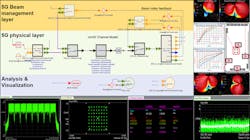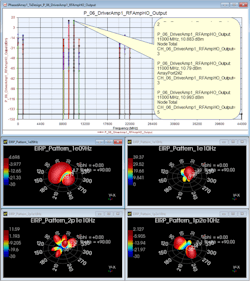Simulate Your Way to Millimeter-Wave 5G Design Success
Download this article in PDF format.
Modern wireless networks have come to a crossroads as mobile users consume more data than ever before, with no signs of that trend abating anytime soon. Data consumption is crammed into an already overcrowded spectrum, which means less bandwidth for each user. The result is slower service and increasingly dropped connections.
Enter the millimeter-wave (mmWave) spectrum. This underutilized frequency spectrum is now being eyed as the answer to the bandwidth shortage. However, the ability to transmit large amounts of data isn’t the only trait that makes mmWaves so appealing. These waves are broadcast at extremely high frequencies, between 30 and 300 GHz, and those high frequencies can deliver faster wireless communication—exactly what 5G aims to deliver.
With its ability to handle much more data traffic at much higher speeds than today’s cellular networks, mmWave is seen as a critical linchpin in making 5G a reality. But that vision is not without its engineering challenges.
Phased Arrays and Beamforming: Challenges Ahead
Two crucial technologies in the delivery of 5G services are the phased-array antenna and hybrid beamforming. Phased-array antennas provide a way to leverage high-capacity—but high-loss—mmWave frequencies for 5G systems. Beamforming controls the direction of the reception or transmission of signals at the antenna array.
Together, these technologies improve signal quality, reduce interference, and boost cell coverage. This is especially vital at the cell edge, where performance demands are at their highest and user devices experience the most degraded signal-to-noise conditions and highest levels of inter-cell interference.
1. Keysight’s SystemVue 2017 supports 5G link-level validation with phased-array antennas and hybrid beamforming in a 100-GHz mmWave channel (based on 3GPP). It is the only simulation tool to implement this advanced channel model.
A key advantage of using beamforming with the phased-array antenna design is that it provides higher link-level gains to overcome direct path loss and undesirable interference sources in 5G systems. The downside is it can be costly to implement, often requiring a transmit/receive (T/R) module dedicated to each antenna-array element.
Hybrid beamforming offers designers a way to mitigate this cost by partitioning beamforming between the digital and RF domains. Hybrid-beamforming designs combine multiple array elements into subarray modules. Also, because a single T/R module can be dedicated to multiple elements in the array, the 5G system requires fewer T/R modules.
While it’s clear that phased-array antennas and hybrid beamforming will be critical to supporting a 5G future, these technologies present two important challenges:
- Accurate verification and visualization of hybrid-beamforming signal performance at the phased-array antenna: Accurate verification is critical to ensuring the 5G system works optimally and that it complies with emerging 5G specifications. The issue is that there are many aspects of a 5G system. Without the right channel models and simulation functionality, accurately verifying they all work together is next to impossible.
- Addressing spurious harmonics and intermodulation interference (intermods): An often overlooked, but extremely important aspect of phased-array antenna design, is simulation of the spurious harmonics and intermods generated by amplifiers and mixers radiating through the phased array. Spectrally, when these beams are at spurious frequencies, they may violate FCC emission rules on allowable effective isotropic radiated power (EIRP). Spatially, the spurious beams may also interfere with nearby antennas or multi-beam operation of the active electronically steered array (AESA). These factors can result in phased-array deployment failures in the field, both in 5G and aerospace/defense applications, which are typically costly and difficult to fix.
Turning to Simulation
These issues can be addressed through simulation, but not just with any commercially available simulation tool. On the contrary, the ideal solution must support emerging and future 5G standards and offer a range of 5G functionality, as well as support for mmWave channels. It should give designers the flexibility to create pre-5G-compliant reference designs. Furthermore, it must allow for verification of phased-array hybrid beamforming and antenna diversity between the base station and handset in 0.5- to 100-GHz mmWave channels with Verizon-KT 5G signals.
The ideal simulation solution should also be able to account for a range of RF effects (e.g., the ability to incorporate S-parameters of off-the-shelf phase shifters and attenuators, and X- or Sys-parameters of nonlinear amplifiers and mixers). As a result, designers could characterize the radiation of spurious intermodulation signals from the array in terms of direction and power, ensuring accurate phased-array antenna design. Additionally, it should offer a 5G standards verification library that cellular systems and component designers can use to start pre-5G now, and continue using when the final 5G New Radio (NR) standards become available.
How would such a simulation tool address the two previously identified challenges? Consider the first challenge: verification. 5G hybrid beamforming requires the design of phased-array antennas that are fed with phase and amplitude excitations. These excitations are generated through the combination of analog-RF phase shifters and attenuators, together with baseband complex precoding signals.
Baseband precoding is a computationally intensive process. It is performed in the base station by estimating the mmWave-channel state information from received user signals, and then selecting the optimal precoding complex modulation from a code book to be applied to the signal streams for each user.
Each user signal stream is further refined through additional complex baseband precoding. This added step ensures optimal transmission from the base-station phased array to the user handset. As shown in Figure 1, the handset may also include multiple antennas. In this figure, the actual electromagnetic (EM) antenna pattern is used to realistically model the signal gain from different orientations of the handset with respect to the base station. A commercially available simulation tool with 5G verification functionality is used for this exercise. Handset diversity simulation is enabled by adaptively switching between antennas with the highest received signal strength for the best data throughput.
Using this process, the complete 5G end-to-end data throughput rate can be simulated realistically to verify that all aspects of the systems are optimally designed to work together, including:
- Hybrid RF-digital beamforming and pre-coding DSP algorithms
- RF phased-array MIMO system architecture at base station
- Handset multiple-antenna placement and radiation patterns
- 5G signals and modulation formats for optimizing time, frequency, and spatial resources
- RF linear and nonlinear components characterized by S-, X-, or Sys-parameters
Much like the solution to the verification challenge, the solution to addressing spurious harmonics and intermods is simulation. By using a simulation tool with 5G functionality, designers can accurately predict the frequency, direction, and root cause of spatially radiated spurious harmonics and intermods.
2. Using SystemVue 2017 can help identify the root cause of spurious intermod beams from a phased array.
By analyzing the root cause of spurious intermods, designers can easily identify how they are generated, the components that generate them, and through what signal paths in the RF chain. With this information, it then becomes possible to fix any flaws before hardware implementation and before they turn into costly, difficult-to-fix problems (Fig. 2).
An Easier Path to 5G
While 5G standards are still evolving, it’s clear the quest for higher data rates will not dissipate any time soon. Higher-frequency mmWave spectrum is one way to accommodate increases in data consumption, but its use further complicates the design and verification process. Fortunately for designers, these challenges can be mitigated through the appropriate simulation.
Granted, finding a simulation tool specifically equipped to handle emerging 5G standards like Verizon-KT 5G, as well as work with mmWave channels, is paramount. A simulation solution can also be used for pre-5G development right now. Once the 5G NR standard is finalized, the tool is even better. It not only gives RF and baseband designers the earliest possible head start in entering the high-margin 5G system and component market, but also puts them on the right path to 5G success.



